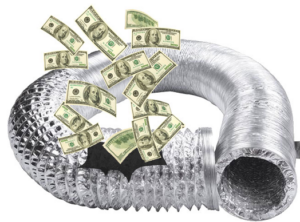Don’t heat and cool your attic or crawlspace!

We rely on our HVAC system to keep our homes cool during the summer and warm during the winter. Air ducts were designed to ensure that our conditioned air gets to where it needs to go. When a leak occurs, your air ducts start working against your HVAC unit, causing it to work harder to ensure your home is at the proper temperature.
COULD YOUR AIR DUCTS BE LEAKING?
Feeling Uncomfortable in Your Home: When you are walking through your house, do you notice that there are temperature fluctuations between rooms? If there are, this could indicate that your air ducts have a leak making it difficult to cool or heat some of the rooms in your home.
On the other hand, a larger leak may cause your home to feel stuffy as the conditioned air is escaping before it can get anywhere. If you are feeling uncomfortable in your own home, you will want to call your trusted HVAC technicians right away to get to the root of the problem.
Low Air Quality: Leaks that occur in the connections outside, especially the intake ducts, may be pulling air from outside and bypassing it through the filters. This can result in pathogens and allergens getting into your home, lowering the air quality.
If the duct leak is occurring in the basement or attic, it can pull in hazardous fumes from stored chemicals, such as paint thinner, fertilizer, or pesticides.
Backdrafting: Appliances like your gas furnace or gas water heater are designed to vent the resulting fumes outside of your home. When your air ducts are leaking, these fumes can draft back into the home. When this happens, dangerous fumes can negatively affect air quality and result in adverse health effects such as headaches and nausea.
High Energy Bills: If you are noticing your energy bills rising every month, it may be due to an air duct leak. An air duct leak will cause your HVAC system to work harder to reach your optimal temperature inside your home. In turn, this causes your energy bills to rise as your system is running more constantly. This can negatively impact your finances and puts increased strain on your HVAC unit which, over time, can cause it to break down.
Frequent Dust In the Home: Are you constantly fighting the never-ending battle against dust? It could be because your air ducts are leaking and bringing in fine particles from either outdoors or other rooms, such as the basement.
Air Duct Insulation
Insulating is a very important step if your ductwork is located in an unconditioned space such as an attic, crawlspace or garage. Unconditioned spaces are those areas, outside of the envelope (conditioned living space) of the home, which are not heated or cooled. Because ductwork is usually made of thin metal that easily conducts heat, it is critical to seal and insulate it properly. This is not required of most flex ductwork because it normally contains its own layers of insulation. Insulating ductwork located in conditioned space is not recommended. It can actually cause adverse affects, such as mold and mildew.
The U.S. Department of Energy estimates that poorly sealed, poorly insulated ducts can waste up to 30% of the energy that goes into heating and cooling your home.
As part of our ductwork insulating service, we will thoroughly inspect and seal the accessible ductwork. Then we will wrap the exterior of the ductwork with insulation. Though some are similar to, this is not the same paperbacked insulation or batting used in your walls or attic. We use a variety of foil-lined insulation products specifically designed for ductwork. These include foil-lined bubble wrap products and foil-lined fiberglass products. The environment and required insulation level will determine the proper product to be used.
Air Duct Disinfecting
Microban® Disinfectant
Microban® is an EPA (U.S. Environmental Protection Agency) registered disinfectant spray. It is a unique water-based bactericide, fungicide, deodorant, and antimicrobial all in one formulation. One application kills allergy- and disease-causing germs, fungi, mold, and mildew. It kills odor-causing bacteria, including gram negative bacteria -- the bacteria encountered in sewage backups and toilet overflow situations. It also provides long-lasting residual protection, so it keeps working, preventing germs and fungi from growing on surfaces long after application.
Microban® Disinfectant Spray vs. Bleach
Goff HVAC does not use nor recommend the use of bleach as a disinfectant in your air ducts. This may be common practice by other companies, but we highly discourage it. Microban® Disinfectant Spray is the top choice of restoration professionals for many reasons, but here are 5 key reasons on why Microban® is superior to bleach:
- Bleach is quite caustic and irritating. Microban® has a neutral pH and is non-corrosive.
- Bleach can corrode metals and damage fiber dyes. Microban® will not damage these surfaces.
- Bleach doesn't provide residual protection after initial application. Microban® has both bacteriostatic and fungistatic capability.
- Bleach leaves significant amounts of residue that can be quite difficult to remove. Microban® has minimal residue.
- Bleach is unstable and can easily emit toxic fumes if improperly handled. Microban® is virtually odor free.
Air Duct Encapsulation
Encapsulating the ductwork is recommended to help control mold growth and prevent the release of dirt particles from the air ducts.
Encapsulating the ductwork involves applying a sealant to the interior of the fiberboard ducts in order to maintain the lifespan of the ductwork. This is a technical process that should only be performed by qualified experts.
Encapsulating the ductwork is highly recommended for fiberglass duct boards and fiberboard. Over time, these materials will erode, allowing the fiberglass to pollute the indoor air. Encapsulating the inside of the ductwork will prevent the fibers from being circulated, potentially causing health issues for those sharing the air space.
